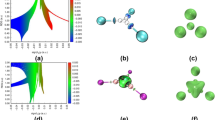Abstract
Ab initio calculations were carried out to investigate the structures and the stability of the noble gas complexes HeAuF and NeAuF through MP2 and CCSD(T) methods. The HeAuF was predicted to have a linear structure with weak He—Au covalent bonding, the distance of which is closer to the covalent limit in comparison with the corresponding van der Waals limit. The dissociation energy with respect to He + AuF was found to be 24 and 26 kJ·mol−1 at the CCSD(T)/basis set B and B′ levels, respectively. However, similar calculations for NeAuF indicate that NeAuF is not a stable species.
Similar content being viewed by others
References
Bartlett N. Synthesis of chemical compound XePtF6. Proc Chem Soc, 1962, 112: 218–218
Evans C J, Gerry M C L. The microwave spectra and structures of Ar-AgX(X=F,Cl,Br). J Chem Phys, 2000, 112: 9363–9374
Michaud J M, Cooke S A, Gerry M C L. Rotational spectra, structures, hyperfine constants, and the nature of the bonding of KrCuF and KrCuCl. Inorg Chem, 2004, 43: 3871–3881
Evans C J, Lesarri A, Gerry M C L. Manipulation and characterization of xenon-metalloporphyrin complexation with a scanning tunneling microscope. J Am Chem Soc, 2000, 122: 6100–6105
Evans C J, Rubinoff D S, Gerry M C L. Noble gas-metal chemical bonding: the microwave spectra, structures and hyperfine constants of Ar-AuF and Ar-AuBr. Phys Chem Chem Phys, 2000, 2: 3943–3948
Cooke S A, Gerry M C L. XeAuF. J Am Chem Soc, 2004, 126: 17000–17008
Evans C J, Gerry M C L. Noble gas-metal chemical bonding? The microwave spectra, structures and hyperfine constants of Ar-CuX(X=F, Cl, Br). J Chem Phys, 2000, 112: 1321–1329
Tapan K G. Properties, dynamics, and electronic structure of atoms and molecules bonding analysis for NgAuOH (Ng = Kr, Xe). J Chem Phys, 2006, 124: 124304-1–124304-7
Cooke S A, Gerry M C L. Insights into the xenon-silver halide interaction from a rotational spectroscopic study of XeAgF and XeAgCl. Phys Chem Chem Phys, 2004, 6: 3248–3256
Reynard L M, Evens C J, Gerry M C L. Microwave Spectrum, Structure and Hyperfine Constants of Kr-AgCl. J Mol Spectrosc, 2001, 206: 33–40
Walker N R, Reynard L M, Gerry M C L. The microwave spectrum and structure of KrAgF. J Mol Struct, 2002, 612: 109–116
Thomas J M, Walker N R, Cooke S A, Gerry M C L. Microporous metal organic materials: Promising candidates as sorbents for hydrogen storage. J Am Chem Soc, 2004, 126: 1235–1246
Michaud J M, Gerry M C L. XeCu Covalent Bonding in XeCuF and XeCuCl, Characterized by Fourier Transform Microwave Spectroscopy Supported by Quantum Chemical Calculations. J Am Chem Soc, 2006, 128: 7613–7621
Mizoguchi A, Endo Y, Ohshima Y J. Rotational spectrum of a salt-containing van der Waals complex: Ar-NaCl. J Chem Phys, 1998, 109: 10539–10542
Pseudopotentials of Stuttgart /koeln group (http://www.theochem.unistuttgart.de/pseudopotentials), 2003
Boys S F, Bernardi F. Calculation of small molecular interactions by differences of separate total energies. Mol Phys, 1970, 19: 553–556
Glendening E D, Reed A, Carpenter J E, Weinhold F. NBO Version 3.1. Madison: University of Wisconsin
Reed A E, Curtiss L A, Weinhold F. Intermolecular interactions from a natural bond orbital, donor-acceptor viewpoint. Chem Rev, 1988, 88: 899–926
Frisch M J, Trucks G W, Schlegel H B, Scuseria G. E, Robb M A, Cheeseman J R, Montgomery J A, Vreven T, Kudin K N, Burant J C, Millam J M, Iyengar S S, Tomasi J, Barone V, Mennucci B, Cossi M, Scalmani G, Rega N, Petersson G A, Nakatsuji H, Hada M, Ehara M, Toyota K, Fukuda R, Hasegawa J, Ishida M, Nakajima T, Honda, Y, Kitao O, Nakai H, Klene M, Li X, Knox J E, Hratchian H P, Cross J B, Adamo C, Jaramillo J, Gomperts R, Stratmann R E, Yazyev O, Austin A J, Cammi R, Pomelli C, Ochterski J W, Ayala P Y, Morokuma K, Voth G. A, Salvador P, Dannenberg J J, Zakrzewski V G., Dapprich S, Daniels A D, Strain M C, Farkas O, Malick D K, Rabuck A D, Raghavachari K, Foresman J B, Ortiz J V, Cui Q, Baboul A G, Clifford S, Cioslowski J, Stefanov B B, Liu G, Li-ashenko A, Piskorz P, Komaromi I, Martin R L, Fox D J, Keith T, Al-Laham M A, Peng C Y, Nanayakkara A, Challacombe M, Gill, P M W, Johnson B, Chen W, Wong M W, Gonzalez C, Pople J A. Gaussian 03, Revision B.05. Pittsburgh PA: Gaussian, Inc, 2003
Evans C J, Gerry M C L. Microwave Spectra, Geometries, and Nuclear Quadrupole Coupling Constants of Ar-AuCl and Kr-AuCl. J Am Chem Soc, 2000, 122: 1560–1561
Bartlett N, Sladky F O. In: Bailar J C, Nyholm H J, trotman-Dickenson R, eds. Comprehensive Ingornic Chemistry, Programon: Oxford, 1973. 213
Pyykkö P. Relativistic effects in structural chemistry. Chem Rev, 1988, 88: 579–593
Pyykkö P. Strong closed-shell interactions in inorganic chemistry. Chem Rev, 1997, 97: 597–636
Peterson K A, Puzzarini C. Importance of the quality of metal and ligand basis sets in transition metal species. Theor Chem Acc, 2005, 114: 283–296
Figgen D, Rauhut G, Dolg M, Stoll H. Energy-consistent pseudopotentials for group 11 and 12 atoms: adjustment to multi-configuration Dirac-Hartree-Fock data. Chem Phys, 2005, 311: 227–244
Wong M W. Prediction of a metastable helium compound: HHeF. J Am Chem Soc, 2000, 122: 6289–6290
Author information
Authors and Affiliations
Corresponding author
Additional information
Supported by the National Natural Science Foundation of China (Grant No. 20403011)
Rights and permissions
About this article
Cite this article
Chen, R., Zhu, H., Xie, D. et al. Theoretical prediction of the noble gas complexes HeAuF and NeAuF. Sci. China Ser. B-Chem. 52, 1987–1990 (2009). https://doi.org/10.1007/s11426-009-0255-0
Received:
Accepted:
Published:
Issue Date:
DOI: https://doi.org/10.1007/s11426-009-0255-0




